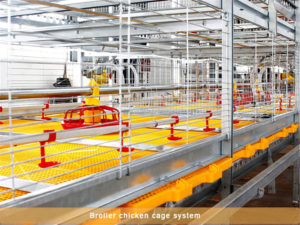Poor environmental conditions in chicken farms tend to reduce the survival rate of chicks and affect the efficiency of farms. Therefore, we need to clean the chicken farms on a daily basis. If the chicken farm environment is bad, the chickens have the following kinds of hazards in chicken cages prices in South Africa
The ammonia in the chicks should not exceed 10 mg per cubic meter, the chicken should not exceed 15 mg; the hydrogen sulfide chicks should not exceed 2 mg, the chicken should not exceed 10 mg; the carbon dioxide should not exceed 1500 mg per cubic meter; the foul odor dilution should not exceed 70. . The above-mentioned substances in the field and living area outside the chicken house are required to be low; the inhalable particles in the air in the house are not more than 4 mg; the total suspended particulate matter is not more than 8 mg per cubic meter, and the number of microorganisms should be controlled at 250,000 per cubic meter. Below, the dust in the air is an important carrier of bacteria.

No good environmental conditions have been created for the survival of the chicken. The main performances are: improper site selection of chicken farms, unreasonable construction of chicken houses, no scientific ventilation system, no attention to ventilation, no ventilation, no ventilation. The chicken field is low-lying and the environment is narrow. Some trees are planted in the forest or a large number of trees are planted in the field, so that the wind can’t get in, the harmful gas can’t be discharged; the distance between the houses is too narrow, the airflow can’t flow well, and the window setting is unreasonable. There are no floor windows, skylights, air shape is not convective, no ventilation equipment or settings are unreasonable; some are afraid that the chickens are cold, frozen and afraid to ventilate, all of which make the chickens live in the absence of oxygen, ammonia, hydrogen sulfide gas for many years. In the environment where methane, carbon dioxide and other gases are seriously exceeded, the external pathogenic microorganisms are not only easy to invade the body of the chicken, but also have frequent ventilation, tissue hypoxia, decreased heart and lung function, insufficient blood oxygen, and the body is in a pathological state. Under the circumstance, a good immune response cannot be produced for immunization.
We often put the respiratory tract disease after ventilation, which is caused by this ventilation, but it is not. It is often 2-3 days before the weather gets warmer or the weather is fine. It is a windless day. At this time, if we close the house, the air inside and outside is not circulating, and the harmful gases in the house are excessive. The pathogenic microorganisms easily sneak into the body and form the disease. The “latency period”, when the weather is warming, the ventilation is not gradual, and there is a subsequent respiratory disease, so ventilation is one of the most important issues in chicken feeding management.